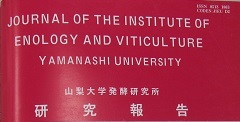

 |
山梨大学醗酵研究所 研究報告[1254年-1997年] JOURNAL OF THE INSTITUTE OF ENOLOGY AND VITICULTURE |
| vol.21 (1986) |
|
「メンブランフィルターを使用した亜硫酸によるワイン酵母の死滅経過の測定法」 Method for the Determination of Sterilizing Process of Wine Yeasts by Sulfite with the use of Membrane Filter 野村 隆弘・兎束 保之・田中 健太郎・志村 健一 TAKAHIRO NOMURA, YASUYUKI UzUka, KENTARO TANAKA, and K EN-ICHI SHIMURA (Department of Fermentation Technology, Faculty of Engineering, Yamanashi University) pp.1-6[PDF] |
|
亜硫酸がワイン酵母に対して示す殺菌作用を化学反応とみなして,その反応速度を解析する方法を開発する目的で本研究を行った。 開発した方法では: 1) pH 3.1の緩衝液培地にワイン酵母を接種し,生育度がEg 68nm=0.1になった時点の菌体を亜硫酸による殺菌反応に供した。 2) 短時間の反応を停止させるには反応液を合成培地で1,000培づつ二段階にわけて100万倍に希釈した。 3) 反応の進行度を測定するには,100万倍希釈液10mlを直径47mm,孔径0.45μmのメンブランフィルター(MF)で濾過して菌を捕捉してから,これを寒天培地上において,30℃,2日間保温してMF上に形成されるコロニーの計数を行った。 4) MF上に出現するコロニー数が30個前後の範囲では、ひとつの試料につき5枚のMFを使用すれば統計学的に有意な結果が得られることがわかった。 5) 亜硫酸添加後の残存生菌数を亜硫酸濃度を変えて測定したところ,いずれの亜硫酸濃度においても死滅の対数法則に従わないことがわかった。 Considering the sterilizing effect of sulfite on wine yeasts as a chemical reaction,we did research to develop a method by which we could analyse the rate of the reaction. In the developed method : 1) Wine yeast cells were inoculated into pH 3.1 buffer medium and the cells, when cell growth reached E 6.0mm=0.1, were used for the sterilizing reaction. 2) The incubation mixture was diluted with a synthetic medium to a million times its volume in two steps of a thousand times dilution to eliminate the sterilizing effect. 3) To determine the progression of the reaction, the cells were caught by filtration through a membrane filter (MF) of 47 mm diameter and 0.45 pm pore size, and then the MF was incubated at 30℃ for two days on YM agar medium.The colonies grown on the MF were counted. 4) It was found that in the range of approximately 30 colonies on one MF the data obtained with the use of five MF per one sample was statistically significant. 5) The surviving cells after the addition of sulfite in differing concentration were counted. We found that the results obtained from all the sulfite concentrations did not follow the law of logarithmic order of death. |
|
「ブドウ樹の生長点培養」 Meristem Tip Culture of Grapevines 山川 祥秀・小池 肇・神野康英 YOSHIHIDE YAMAKAWA, HAJIME Koike, and YASUHIDE KAMINO (The Experimental Vineyard, the Institute of Enology and Viticulture, Yamanashi University) pp.7-16[PDF] |
|
A suitable method for the regeneration of intact grapevines was investigated using the meristem tip culture for obtaining virus-free grapevines. Five cultivars used were “Koshu', "Koshu-sanjaku”, “Chardonnay", "Riesling' and “Cabernet Sauvignon'. 1) An optimum medium for meristem tip culture was tested using various modified Mura shige and Skoog (MS) Media. The growth rate of inoculated meristem tips was the highest when the medium was composed of the MS diluted 2-fold, 0.1mg NAA/1, 1.0 mg BA/1, 0.5mg kinetin/l,4.0mg adenine/l,30g sucrose/l, and 6g agar/1 (pH 5.8). 2) For the greening and enlargement (stage A), and the monstorus leaf formation (stage B) of the inoculatd meristem tips, appropriate auxine was IAA for ‘Koshu' and ‘Koshu-sanjaku', IBA for 'Chardonnay', and NAA for ‘Riesling' and 'Cabernet Sauvignon’. 3) For the formation of multishoot (stage C), the MS diluted 2-fold,0.2mg IAA/I,1.0mg BA/I,0.5mg kinetin/1,4.0mg adenine/l and 30g sucrose/l were used,but for the opening of small leaves (stage D), the concentrations of BA and sucrose were half those described above. 4) For the rooting (stage E), the MS diluted 2-fold and 15g sucrose/l were required for all the cultivars. Furthermore, the optimum concentration of NAA was 0.10 mg/l for Koshu' and 'Koshu-sanjaku' and 0.02 mg/l for ‘Chardonnay', 'Riesling' and 'Cabernet Sauvignon'. 5) After the potting and habituation (stage F), those plants were easily established in soil. |
|
[ノート] 「紫外吸収法と指示薬発色法の同時検出を用いた高速液体クロマトグラフィーによるワイン中の有機酸分析」 Analysis of Organic Acids in Wines by High Performance Liquid Chromatography using a Continuous-Flow, Dual Spectrophotometric Detection System 横塚弘毅・松土俊秀・西野なか子 KOKI YOKOTSUKA, TOSHIHIDE MATSUDO, and NAKAKO NISHINO (Laboratory of Wine Chemistry, Institute of Enology and Viticulture, Yamanashi University,Department of Fermentation Technology, Faculty of Engineering,Yamanashi University) pp.17-25[PDF] |
|
Organic acids in 11 Koshu white wines and 11 Muscat Bailey A red wines produced in different years were analyzed by continuous-flow high performance liquid chromatography (HPLC).Two spectrophotometric detection methods were used in sequence, the first measuring ultraviolet absorbance at 210nm and the second, after development with bromocresol purple, measuring visible absorbance at 430nm.The wines were treated with 1% charcoal at pH7.5 prior to HPLC. It was not possible to analyze succinic acid using ultraviolet absorption at 210nm as the detection method.This was due to the presence of unknown substances in the wine which were also absorbed at 210nm and eluted in the same position as succinic acid. Similarly,using bromocresol purple,experimental values for malic acid were also fairly lowered due to unknown substances in the wine which were eluted in the same position as malic acid and may have interfered with color development with the malic acid.However, the experimental values obtained by these two detection methods for organic acids other than succinic acid and malic acid were not considerably different. |
The Institute of Enology and Viticulture, University of Yamanashi 所在地:〒400-0005 山梨県甲府市北新1丁目121 |
ホ-ムペ-ジに掲載の文章・記事・写真・図表などの無断転載を禁止します。